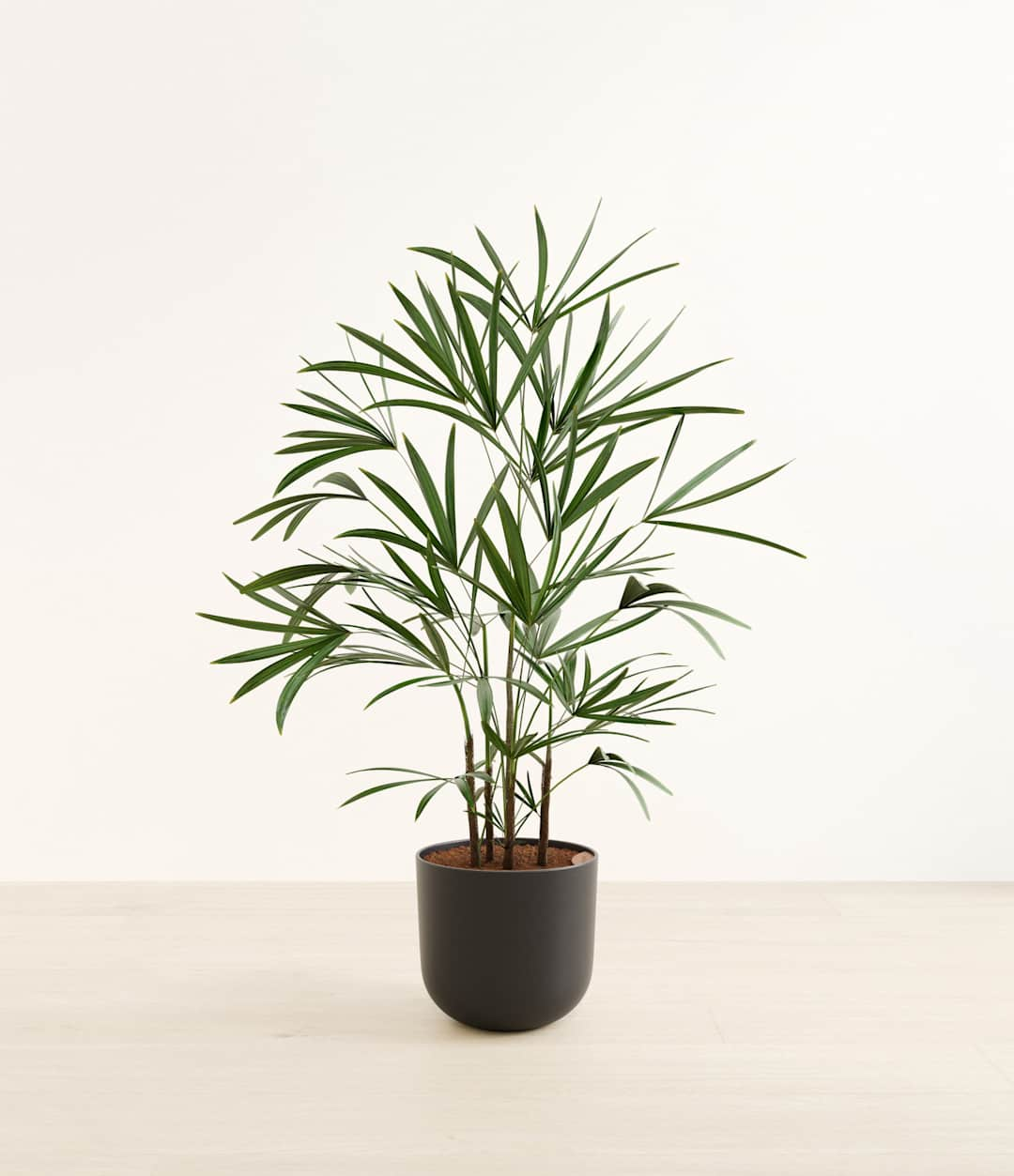How to care for Lady Palm
Shop this plantAbout Lady Palm
The Lady Palm, scientifically known as Rhapis excelsa, is a robust and elegant palm native to the forested regions of Southeast Asia. This palm is renowned for its deep green, fan-shaped leaves, segmented by glossy, broad fronds that gracefully extend from slender, fibrous trunks. Lady Palm is not just appreciated for its aesthetic appeal; it is also celebrated for its adaptability to indoor environments and its air-purifying qualities, making it a cherished addition to both homes and offices.
Other common names
- Bamboo Palm
- Broadleaf Lady Palm
- Miniature Fan Palm
How Often Should I Water My Lady Palm?
With easyplant, which is a self-watering pot, your Lady Palm will benefit from a more regulated water intake. Simply check the easyplant reservoir once a month and fill it when empty, and you're all set!
Lady Palm Light Needs
Lady Palm grows best in a well-lit space with bright indirect sunlight and can adapt to both direct sunlight and low light. Avoid placing it in spaces without natural sunlight.
Lady Palm is well-suited to low light conditions, thriving in areas where natural light is filtered or indirect. It is ideal for placing in north-facing rooms or in locations with partial shade where direct sunlight does not reach directly.
Lady Palm Plant Care
Lady Palm is celebrated for its low-maintenance requirements, making it a favorite among both novice and experienced plant enthusiasts. To ensure the health and beauty of your Lady Palm, regular dusting of the leaves is essential. This not only keeps the plant looking fresh but also maximizes its ability to perform photosynthesis effectively by removing any dust accumulation that could block light. Regular cleaning also helps in identifying any pests or diseases early, which is crucial for the plant's long-term health. Remember to rotate your Lady Palm occasionally to ensure even growth on all sides, especially if the light source is coming predominantly from one direction.
How Big Will My Lady Palm Grow?
In a typical indoor setting, the Lady Palm reaches an impressive height of 4-6 feet, making it an ideal choice for decorating floor spaces in both homes and offices. The growth rate of the Lady Palm ranges from slow to moderate, depending on the care and environment provided. Besides vertical growth, the Lady Palm also tends to spread outwards, forming thick clumps of lush, dark green foliage. This outward growth not only adds to the aesthetic appeal of the space but also allows the palm to fill in areas, creating a denser, more vibrant look.
Temperature & Humidity
The ideal temperature range for the Lady Palm is between 60-80°F (16-27°C). It is capable of adapting to a wide range of humidity levels; however, higher humidity tends to promote more vigorous growth and enhances the health of the leaves. In environments with dry air, particularly during the colder winter months when heating systems are often used, the air around the plant can become too dry. This may lead to issues such as brown leaf tips or reduced growth. To counteract this, consider using a humidifier in the room, or set up a pebble tray filled with water near the plant. As the water evaporates, it increases the moisture level in the air, benefiting the palm.
Is Lady Palm Toxic for Pets & Kids?
One of the most appealing features of the Lady Palm is its non-toxic nature, making it completely safe for homes with pets and children. Unlike many other houseplants, there is no risk of toxicity if leaves are accidentally chewed or ingested. This makes the Lady Palm an excellent choice for families seeking to keep a safe and green environment.
Troubleshooting Common Problems with Lady Palm
Lady Palms are generally robust but may encounter a few common issues such as brown leaf tips, which often indicate low humidity or inconsistent watering—using a pebble tray can help maintain an ideal moisture level. Yellowing leaves could suggest overwatering or poor drainage, so ensure your watering routine aligns with the plant’s needs, particularly in colder months when less water is required. Spotting on leaves might be a sign of pest infestations or fungal infections; regular cleaning of leaves can prevent these problems. If growth seems slow or the foliage appears sparse, consider moving your palm to a brighter location as adequate light is crucial for healthy growth.
Frequently Asked Questions about Lady Palm Plant
- Do lady palms like sun or shade?
Lady Palms prefer shaded areas or indirect sunlight. They are well-adapted to thrive in the lower light conditions of indoor environments, making them perfect for brightening up less sunny spots in your home.
- Is Lady Palm a good indoor plant?
Absolutely! Lady Palm is an excellent indoor plant. It's not only loved for its aesthetic appeal, but it's also one of the best plants for purifying the air. Its ability to adapt to various light conditions and its non-toxic nature make it a great addition to any indoor setting.
- How do you take care of a Lady Palm?
Caring for a Lady Palm involves keeping it in indirect light, providing it with consistent moisture, and dusting its leaves to keep it clean. It's a very forgiving, low-maintenance plant, making it ideal for those new to plant care or with busy lifestyles.
- What are the benefits of the Lady Palm?
The Lady Palm is not only visually appealing, but it also offers air-purifying benefits, helping to remove toxins from the environment. It's also non-toxic and safe for pets and kids, making it a worry-free choice for a household plant.


